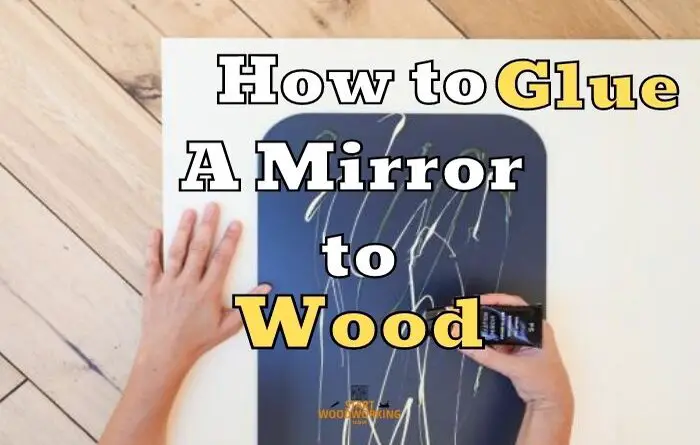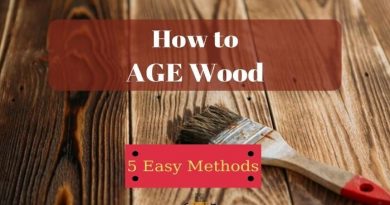How to Glue a Mirror to Wood (Fast & Effective)
After all, how to glue mirror to wood? Is it possible to perform the task on your own? If you want to attach a mirror to a wood, you don’t necessarily have to drill through your beautiful wood. Instead, you can just glue the mirror in place. In the following we explain step by step what you need to do and which adhesive is suitable for this.
How do you attach a mirror to a wood?
Place the mirror on top of the wood, and gently press down on the entire surface so that the mirror grabs the glue and sticks to the wood underneath. Place small clamps around the edge of your mirrored wood so the two stick together as they dry.
How to Glue a Mirror to Wood
Materials required
In order to really permanently glue the mirror to the wood, you need certain material. Above all, the following tools should be available in addition to mirror and glue:
- Mirror glue(mirror adhesive) or double-sided tape
- Detergent
- Sandpaper
- Cloth or Cleaning wipes
- Caulking gun
- Nail polish remover
One of the most important things to remember is to use only special mirror glue. Conventional glue and above all silicone attack the reflective foil of the mirror. You should therefore buy special mirror adhesive or mirror silicone in the hardware store.
Alternatively, you can also use double-sided tape. You should use the strongest possible adhesive tape, such as mounting tape, especially for larger mirrors.
Step 1: Cut the wood to the size of the mirror
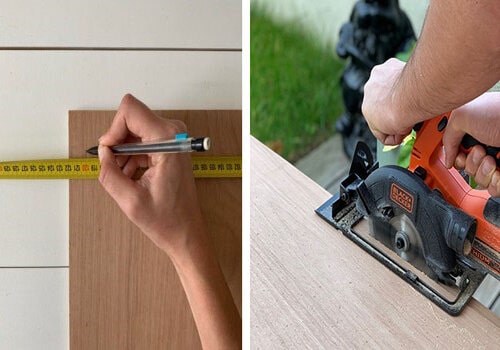
The first thing we have to see is the size of the wood and the mirror that we want to glue . We take the measurements and send them to cut if we do not have the the proper tools at home.
Once the wood and the mirror are cut. We proceed to prepare the wood surface where we are going to glue the mirror.
Step 2: Prepare the wood surface for gluing
Clean the surface and free it of grease. For example, use soapy water and then detergent to remove the grease.
We pass a sandpaper in such a way to remove the varnish from wood that it may have and it is easier to stick the mirror on it. Then with a cloth moistened with acetone we remove the residues.
To do this, clean the back of the mirror and the wood where the mirror should be glued with a cloth and nail polish remover or white spirit. Wipe everything with a microfiber cloth and wait for everything to dry. In order to start gluing we need the mirror and wood surface to be completely dry.
If the wood is untreated this means it has an open pore structure that absorbs moisture so this will prevent you to glue a mirror on wood.
The volatile substances of the glue, sealant or tape absorb very quickly into the wood, causing the adhesion to deteriorate very quickly.
So we first have to pre-treat this wood and you can do that with primer. Primer prevents the absorbing effect of wood, so that the mirror adheres better to the wood.
Wood fibers come up and you can also feel this when you run your hand over the wood. Sand these wood fibers away with sandpaper (220 grit). Sand very lightly with little pressure. The point is that the fibers are gone and we have a smooth wood surface.
Step 3: Take measurements
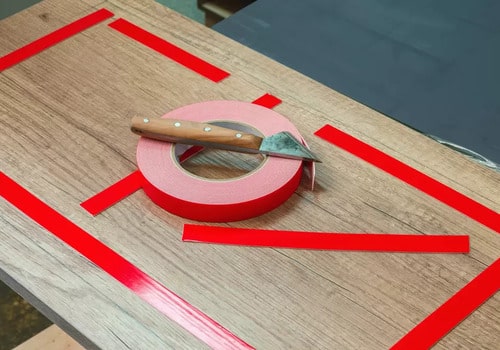
You can then measure exactly where the mirror should go. Use a tape measure and pencil to mark the mirror. To do this, simply make strokes at the top, bottom and corners of the mirror. Use a spirit level to check that the drawings are level.
Use a pencil to mark the top or bottom edge of the mirror and the two corners. However, before you mark the position, check that the mirror is hanging exactly straight, by using spirit level to check that the line is horizontal.
In addition, it makes sense for the mirror (depending on the environment) to be glued on in such a way that the same distance to the wood remains on the left and right. Therefore, align the mirror with the help of a folding rule.
It’s also easier with small mirrors.
Once you have marked the markings, place the mirror face down on a large blanket so that it cannot be damaged.
Step 4: Glue the Mirror to Wood Frame
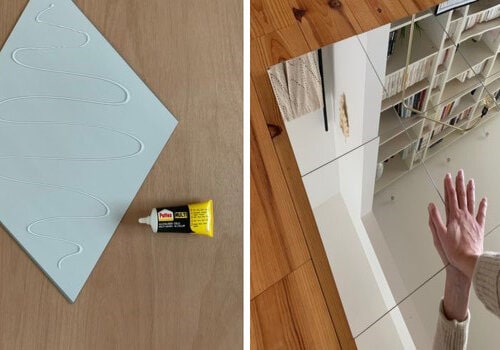
If you glue the mirror by mirror glue then use a standard caulking gun to apply it. Glue adheres well when the surface is flat. Try to hang the mirror on a flat surface.
Apply vertical stripes of mirror glue on the back of your mirror (thickness of the stripes 2-3mm). Apply the glue on the back in vertical lines, with a space of 10 cm. Avoid applying the glue too close to the mirror edge, otherwise you will have to clean up the excess glue.
By applying it in vertical lines you prevent moisture from remaining on the adhesive layer, for example with a mirror in the bathroom. In this way you will enjoy the custom mirror many times longer. It is possible to move the mirror up to approximately 2 minutes after gluing.
If you prefer to seal the connection between, for example, mirrors or the surrounding surface to, for example, prevent moisture from entering behind the mirror, this is best done after the mirror adhesive has cured (approx. 1 to 2 weeks).
Make sure to apply glue especially to the edges and corners of the mirror then press the mirror onto the wood. Using the spirit level check right away if the mirror has been place properly onto the wood surface.
Apply the glue, tape or sealant to the mirror according to the instructions on the packaging. Strictly follow the instructions because then little can go wrong.
Now let the mirror dry according to the manufacturer’s instructions (on the adhesive package insert). The glue needs 24 hours to dry properly. During this time the mirror must be supported.
We put enough to hold the mirror to the wood, following the instructions, finally we remove the protection and stick it to the wood exerting a little pressure.
Use white spirit to clean and remove the remaining glue residue from the mirrors sides. Dried glue residues can only be removed mechanically.
Step 5: Place the mirror on the wall
Now place the mirror on the wall and press gently and evenly. You can still position the mirror if it is attached to the surface. And to stick the wood to the wall we use the system of hooks and closed eyebolts. And we have a new mirror , taking advantage of the materials we have at home.
Do not wait too long because the glue is already drying. You can possibly support the mirror so that it cannot slide down while drying.
Position the mirror on the wall with help, make sure it is placed exactly where marked and check that it is straight using a spirit level.
Press the mirror firmly against the wall. You can use an adhesive strip to hold the mirror in place until the glue is completely dry. The drying time is indicated by the manufacturer.
Amount of double-sided tape required for gluing mirrors
| Mirror surface cm2 | Mirror thickness 3 mm | Mirror thickness 4 mm | Mirror thickness 5 mm | |||
|---|---|---|---|---|---|---|
| belt width 19 mm | tape width 25 mm | belt width 19 mm | tape width 25 mm | belt width 19 mm | tape width 25 mm | |
| 600 | 14 cm | 11 cm | 19 cm | 14 cm | 24 cm | 18 cm |
| 800 | 19 cm | 14 cm | 25 cm | 19 cm | 32 cm | 24 cm |
| 1000 | 24 cm | 18 cm | 32 cm | 24 cm | 39 cm | 30 cm |
| 1200 | 28 cm | 22 cm | 38 cm | 29 cm | 47 cm | 36 cm |
| 1400 | 33 cm | 25 cm | 44 cm | 34 cm | 55 cm | 42 cm |
| 1600 | 38 cm | 29 cm | 51 cm | 38 cm | 63 cm | 48 cm |
| 1800 | 43 cm | 32 cm | 57 cm | 43 cm | 71 cm | 64 cm |
| 2000 | 47 cm | 36 cm | 63 cm | 48 cm | 79 cm | 60 cm |
| 2200 | 52 cm | 40 cm | 69 cm | 53 cm | 87 cm | 66 cm |
| 2400 | 57 cm | 43 cm | 76 cm | 58 cm | 95 cm | 72 cm |
| 2600 | 62 cm | 47 cm | 82 cm | 62 cm | 103 cm | 78 cm |
| 2800 | 66 cm | 50 cm | 88 cm | 67 cm | 111 cm | 84 cm |
| 3000 | 71 cm | 54 cm | 95 cm | 72 cm | 118 cm | 90 cm |
How to Glue a Mirror to a Wooden Surface
Flat mirrors that hang on the wall, such as in a bathroom, can be embellished by adding a wooden border or frame. You can also use a wood frame to cover the edges of mirrors that have started to peel or have become discolored or damaged.
Wood frames can be attached to a mirror using epoxy glue. You can also use mirror tape if you don’t want to use epoxy glue.
Using epoxy glue
Clean the mirror with window cleaner and a towel. You need the edges of the mirror to be clean and free of dirt for the epoxy to bond properly.
Place the wooden strips on the edges to form the frame of it in the position where you would like to glue them. Make sure the frame overhangs the edge or perimeter of the mirror by about 1/2 inch if you are going to hang it on a wall.
Use a tape measure or painter’s tape to measure where the inside frame of the mirror will go.
Put a thin layer of epoxy on the back of each strip of wood and lay them on the mirror. Follow the instructions on the container to mix and apply the epoxy.
Secure the wood frame to the mirror using clamps or painter’s tape to keep the frame from moving until the epoxy dries.
Remove the clips or tape off after the epoxy has dried.
Using mirror tape
Measure the length and width of the frame with a tape measure.
Transfer the results to the mirror tape and cut sections to match this measurement.
Apply the mirror tape to the back of the wood frame.
Peel the wax paper off the mirror tape.
Place the wood frame on the mirror and press it against the mirror so that the adhesive from the tape sticks to it.
Advice
Test the epoxy on a discarded piece of glass to see how well the epoxy will work.
Use a faster setting epoxy than a wood with glass.
Use mirror tape if the epoxy doesn’t work as expected.
How to Glue a Mirror to Wood Cabinet
The mirror can also be glued to the cabinet door, thereby updating the interior of the room. Since the mirror will not be used in a large size, double-sided tape, special for mirrors, is used.
First, it is glued along the perimeter to the back wall of the mirror, then at regular intervals of 40 centimeters it is supplemented with vertical strips of adhesive tape.
After that, the mirror is carefully glued to the cabinet. We advise you to mark in advance with a pencil the borders of the future mirror on the wood cabinet.
Frequently Asked Questions
What is the best glue to glue mirror to wood?
The best adhesive or bonding agent for glass is known as epoxy. POXIPOL epoxy glue is a two-component adhesive. To glue the mirror to a wooden object, equal parts of both components must first be mixed together, until a uniform color is obtained.
What kind of glue to glue mirror?
The mirror fixed glue is a super resistant adhesive that helps to fix on walls, wood, tiles and other materials. It is produced with silicone and has super fast action, allowing adhesion between 30 minutes and two hours, maximum.
How to glue mirror on MDF wood?
To increase security, the mirror can be glued to a thin wooden or MDF board, 6 or 10 mm thick. The resistance increases and, in case of breakage, the shards are stuck in the plate. Another way to improve safety is to use a film glued behind the mirror.
Can you glue mirrors with silicone?
You can used silicone sealant. It is sticky enough to hold a mirror. Will not damage the mirror. Fill in the gap if the wall is not flat or has dents.

